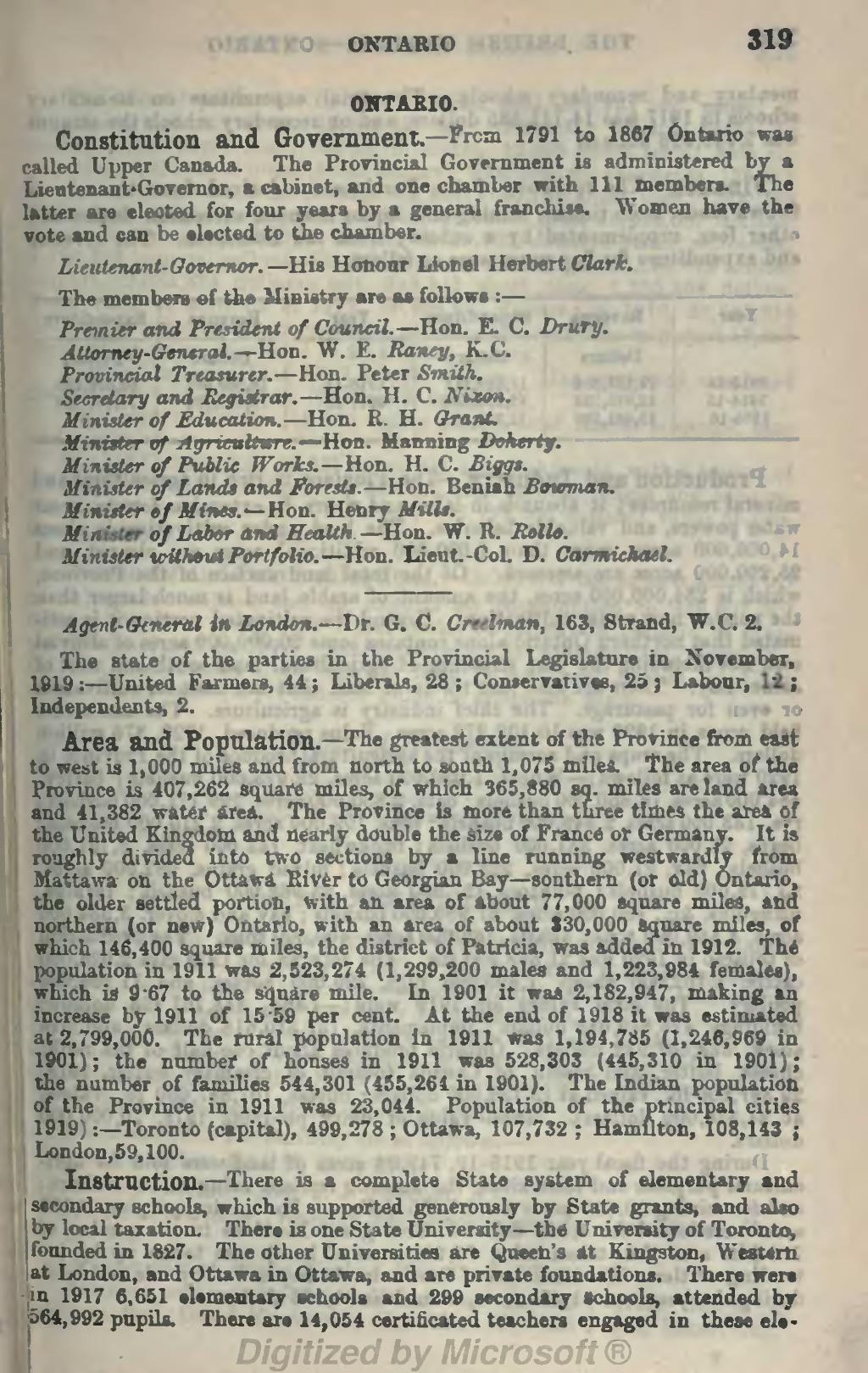ONTARIO 319
ONTARIO.
Constitution and Government.— Frcm 1791 to 1867 Ontario was
called Upper Canada. The Provincial Government is administered by a Lieutenant-Governor, a cabinet, and one chamber with 111 members. The latter are elected for four years by a general franchise. Women have the vote and can be sleeted to the chamber.
Lieutenant-Governor. — His Honour Lionel Herbert Clark.
The members of the Ministry are as follows : —
Premier and President of Council.— Hon. E. C. Dri ,' Attorney -General.— Hon. W. K. Ranry, K.C. Provincial Treasurer. — Hon. Peter Smith. Secretary and Registrar. — Hon. H. C. Nixon. Minister of Education.— 'Ron. R. H. Grant. Minister of Agriculture. — Hon. Manning Doherty.
ster of Public Works.— Ron. H. C. Biggs. Minister of Lands and Forests. — Hon. Beniah Bowman. Minister of Mines. — Ron. Henry Mills. Minister of Labor and Health —Hon. W. It. Rollo.
uier v-ithout Portfolio.— Ron. Lieut. -Col. D. Carmichael.
Agent-General in London.— Dr. G. C. Creelman, 163, Strand, W.<'. 2.
The state of the parties in the Provincial Legislature in November, 1919 : — United Farmers, 44 ; Liberals, 28 ; Conservatives, 25 ; Labour, 12 ; Independents, 2.
Area and Population. — The greatest extent of the Province from east to west is 1,000 miles and from north to south 1,075 miles. The area of the Province is 407,262 square miles, of which 365,880 sq. miles are land area and 41,382 water area. The Province is more than three times the area of the United Kingdom and nearly double the size of France or Germany. It is roughly divided into two sections by a line running westwardly from Mattawa on the Ottawa River to Georgian Bay— southern (or old) Ontario, the older settled portion, with an area of about 77,000 square miles, and northern (or new) Ontario, with an area of about 130,000 square miles, of which 146,400 square miles, the district of Patricia, was added in 1912. The population in 1911 was 2,523,274 (1,299,200 males and 1,223,984 females), which is 9-67 to the square mile. In 1901 it was 2,1S2,947, making an increase bv 1911 of 15 59 per cent. At the end of 1918 it was estimated at 2,799,000. The rural population in 1911 was 1,194,735 (1,246,969 in 1901); the number of houses in 1911 was 528,303 (445,310 in 1901); the number of families 544,301 (455,261 in 1901). The Indian population of the Province in 1911 was 23,044. Population of the principal cities 1919) :— Toronto (capital), 499,278 ; Ottawa, 107,732 ; Hamilton, 108,143 ;
' London, 59, 100.
Instruction. — There is a complete State system of elementary and secondary schools, which is sup}>orted generously by State grants, and also
', by local taxation. There is one State University — the University of Toronto,
ifounded in 1827. The other Universities are (Queen's at Kingston, Western at London, and Ottawa in Ottawa, and are private foundations. There were
tun 1917 6,651 elementary schools and 299 secondary schools, attended by 564,992 pupils. There are 14,054 certificated teachers engaged in these ele-
